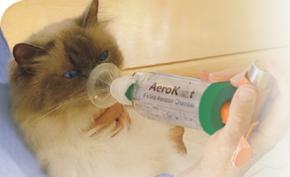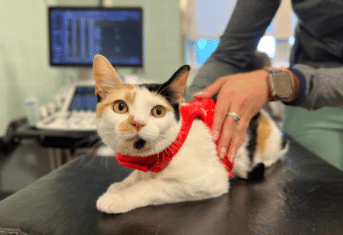Cats Can't Steal Your Breath, But Asthma Can Steal Theirs

Cats Can't Steal Your Breath, But Asthma Can Steal Theirs
This blog is written in honor of our furry feline friends. Remember, June is Adopt-a-Cat Month, so visit your local animal shelter to add a feline to your family.
My mother was a dog person, not a cat person. Because of her views on cats, she was convinced that the minute I brought her grandson home from the hospital, my beloved cats would jump into the crib and suck the life out of her new grandchild. Where this myth came from, I have no idea, but the cats would have nothing to do with the little screamer and all of us managed to survive the experience of a new baby in the household.
Even though cats cannot suck the breath out of you, they may develop breathing problems of their own. One cause of breathing problems in cats is heart disease. Heart disease occurs frequently in cats, and with it comes fluid in the lungs. Fluid buildup in the lungs causes cats to breathe quickly since the fluid blocks the ability of the lung to extract oxygen from each breath. The respiratory rate increases in an attempt to compensate for a lack of oxygen in the body.
Like humans, cats can also develop asthma. Although the underlying disease process in cats is not identical to that in humans, both human and feline asthma patients suffer from sudden, intense bouts of coughing, wheezing and respiratory distress. Cat owners sometimes mistake coughing episodes for unsuccessful attempts to yack up a hairball. When I examine a cat with asthma, I usually see an increased respiratory rate and hear wheezing lung sounds with my stethoscope. X-rays will show thick bronchi (breathing tubes in the lungs). The bronchi thicken as the walls fill up with cells called eosinophils. These cells cause inflammation and block airflow to the lungs. Sometimes veterinarians treat asthma based on clinical and x-ray findings. Other times we perform a tracheal wash or a bronchoalveolar lavage to get samples of the cells inside the lungs and also to see if there is a concurrent bacterial infection. Treatment for cats is similar to treatment for humans with asthma and includes bronchodialtors to make breathing easier and steroids to decrease inflammation. These medicines can be given orally, but oftentimes side effects can be limited by using inhalation therapy with a metered dose inhaler and a special cat mask and spacer as shown in the photograph.
Can’t tell coughing from vomiting? In either case, see your cat’s veterinarian for an evaluation. Practice counting your cat’s respiratory rate when she’s healthy so you recognize an increased respiratory rate. Normal cats breathe about 30 times a minute. Remember one breath equals an inspiration and expiration. Not sure you have the technique quite right? Your veterinarian or veterinary technician can help you learn.

































